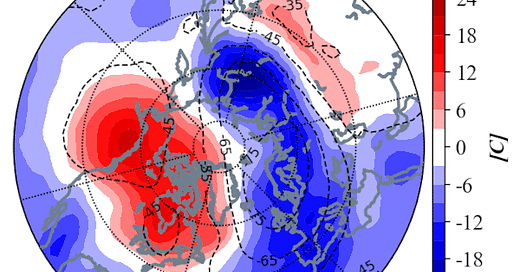Climastrologists: Our Iconic 'Fingerprint' Of Global Warming (Accelerated Tropospheric Warming) Is Missing. No Worries: Catastrophic Stratospheric Cooling Is Now The New Irrefutable Fingerprint
The alleged unmistakable fingerprint of man-made greenhouse gas global warming is accelerated warming in the troposphere (most especially the mid troposphere above the tropics due to strong water vapour feedbacks), combined with cooling in the upper atmosphere (the stratosphere) which lies above the troposphere. For years, scientists have assured us of this ‘fact’ but the reality is, the accelerated warming in the troposphere predicted by the climate models has not happened. For years, they’ve searched for it, like the famed Scarlet Pimpernel, but they’ve failed to find it:
They seek him here, they seek him there
Those Frenchies seek him everywhere
Is he in heaven or is he in hell?
That damned elusive Pimpernel
The more they look, the less likely it is that they will find it, it would seem. Recently, NOAA updated their STAR satellite dataset - which hitherto had shown quite strong warming in the troposphere - and rather embarrassingly, the new version agrees closely with UAH data, which for years has shown only weak warming in the troposphere and which was labelled by alarmists as an ‘outlier’. So, in response to being unable to find the signature of global warming in the troposphere, climastrologists have switched their attentions to the stratosphere, where it can be demonstrated that cooling is taking place. This, according to a recent paper by Santer et al, is “incontrovertible” evidence of the signature of man-made global warming. The message basically goes: ‘We couldn’t find enough warming in the troposphere to provide ‘irrefutable evidence’ of anthropogenic greenhouse gas warming, so we found cooling in the stratosphere instead. Cooling is the new warming.’
Early climate modelers predicted back in the 1960s that this combination of tropospheric warming and strong cooling higher up was the likely effect of increasing CO2 in the air. But its recent detailed confirmation by satellite measurements greatly enhances our confidence in the influence of CO2 on atmospheric temperatures, says Santer, who has been modeling climate change for 30 years.
In May, he used new data on cooling in the middle and upper stratosphere to recalculate the strength of the statistical “signal” of the human fingerprint in climate change. He found that it was greatly strengthened, in particular because of the additional benefit provided by the lower level of background “noise” in the upper atmosphere from natural temperature variability. Santer found that the signal-to noise ratio for human influence grew fivefold, providing “incontrovertible evidence of human effects on the thermal structure of the Earth’s atmosphere.” We are “fundamentally changing” that thermal structure, he says. “These results make me very worried.”
CHEMISTRY IS NOT the only issue. Atmospheric physicists are also growing concerned that cooling could change air movements aloft in ways that impinge on weather and climate at ground level. One of the most turbulent of these phenomena is known as sudden stratospheric warming. Westerly winds in the stratosphere periodically reverse, resulting in big temperatures swings, during which parts of the stratosphere can warm by as much as 90 degrees F (50 degrees C) in a couple of days.
This is typically accompanied by a rapid sinking of air that pushes onto the Atlantic jet stream at the top of the troposphere. The jet stream, which drives weather systems widely across the Northern Hemisphere, begins to snake. This disturbance can cause a variety of extreme weather, from persistent intense rains to summer droughts and “blocking highs” that can cause weeks of intense cold winter weather from eastern North America to Europe and parts of Asia.
This much is already known. In the past 20 years, weather forecasters have included such stratospheric influences in their models. This has significantly improved the accuracy of their long-range forecasts, according to the Met Office, a UK government forecasting agency.
The question now being asked is how the extra CO2 and overall stratospheric cooling will influence the frequency and intensity of these sudden warming events. Mark Baldwin, a climate scientist at the University of Exeter in England who has studied the phenomenon, says most models agree that sudden stratospheric warming is indeed sensitive to more CO2. But while some models predict many more sudden warming events, others suggest fewer. If we knew more, Baldwin says, it would “lead to improved confidence in both long-term weather forecasts and climate change projections.”
No, seriously, cooling is the new warming, not just in the stratosphere, but at the surface too. They’re cannily linking the trend in stratospheric cooling (due to global warming) to a supposed increase in sudden stratospheric warmings which, at the surface during winter, translate as extreme cold weather. So, warming begets cooling, begets sudden warming, begets cooling - got it? Handy: the “incontrovertible” fingerprint of man-made global warming is causing extreme winter weather. OK, not all models predict this - some predict the opposite - but I’m sure those renegade models will be conveniently ignored when it comes to explaining how the increase in sudden stratospheric warmings producing extreme cold weather in the USA and elsewhere is really the result of global warming.





That's why the phear porn lie first labeled "Global Warming" became the completely absurd "Climate Change". You would think that marketing switch would clue more people into the scam.
Jaime, you are the best!!! Another great example of flipping the script. I really enjoyed this one. Thank you for sharing this with us.